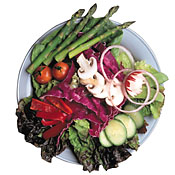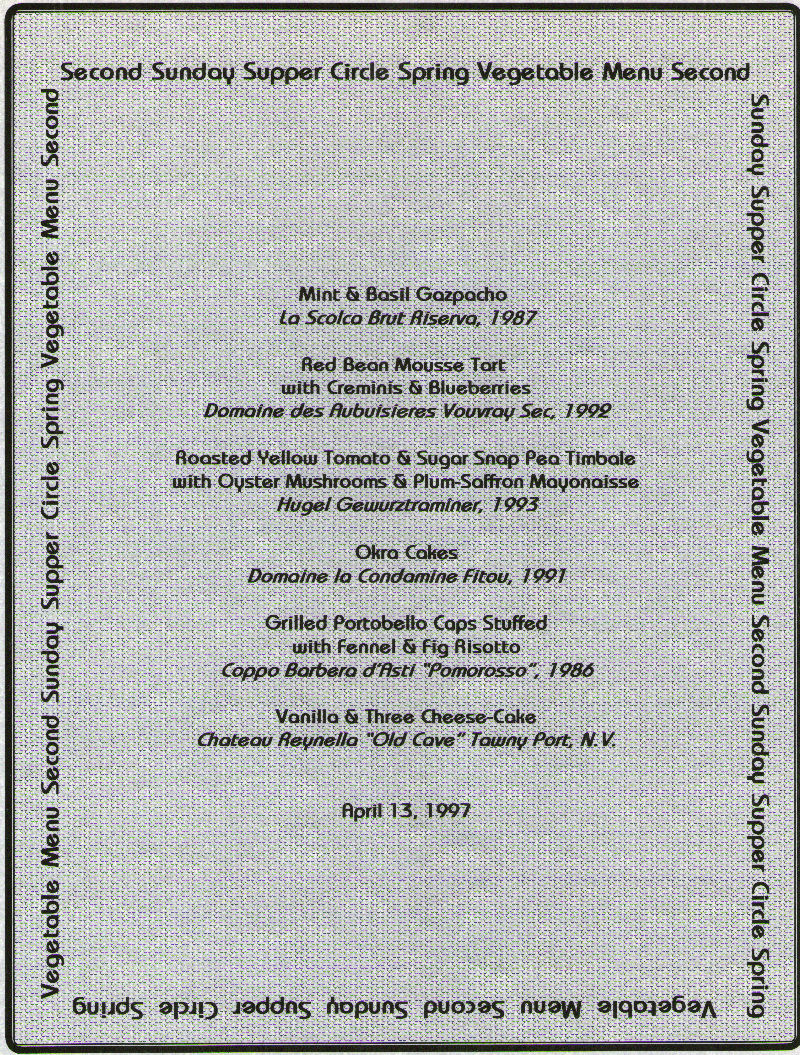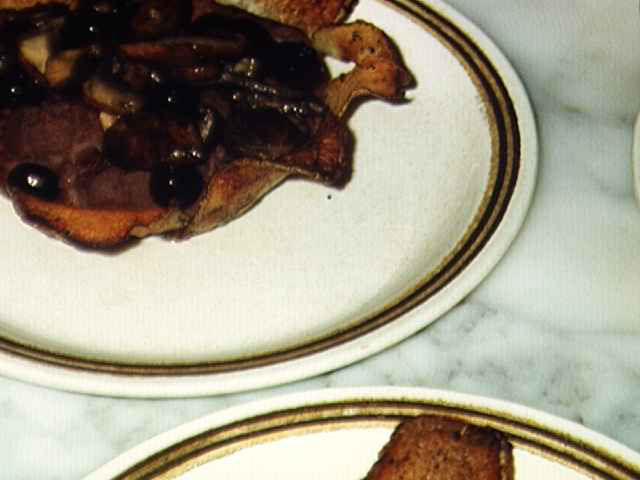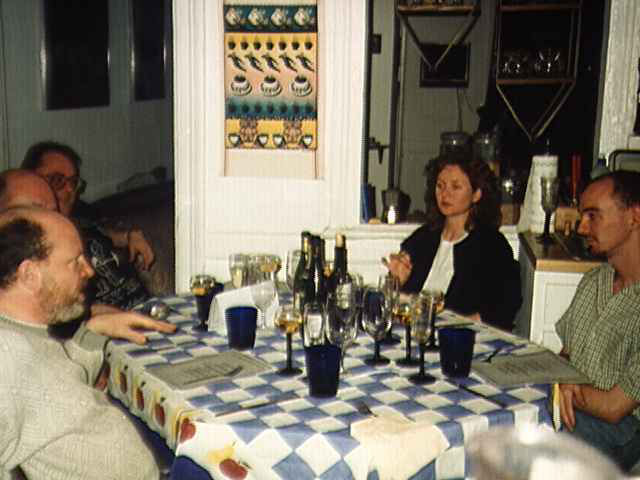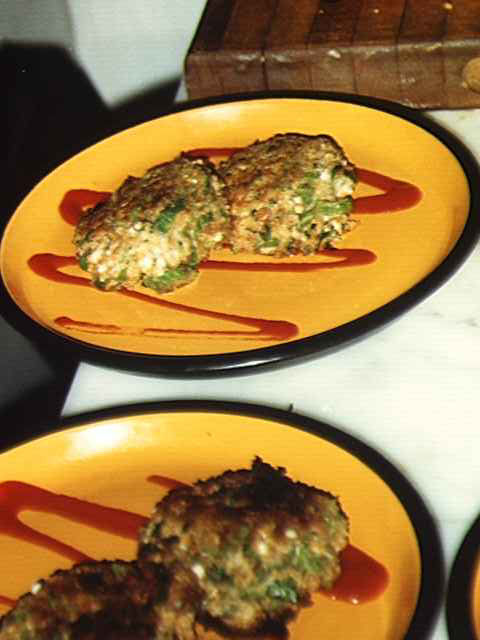Harvest Fusion
November 1997
Pages 44-45
 Multiculturalism is the “ism” of the 1990s and food is no exception. I recently returned to my hometown in the Midwest to discover a new “multicultural” restaurant had opened in the midst of the university campus. The menu stated that each selection had been carefully designed to include “elements of the native cuisines of at least five foreign peoples.” The place was packed, the food was clashingly inedible, but everyone seemed to feel they were politically correct for eating there.
Multiculturalism is the “ism” of the 1990s and food is no exception. I recently returned to my hometown in the Midwest to discover a new “multicultural” restaurant had opened in the midst of the university campus. The menu stated that each selection had been carefully designed to include “elements of the native cuisines of at least five foreign peoples.” The place was packed, the food was clashingly inedible, but everyone seemed to feel they were politically correct for eating there.
Now, mind you, I’m not opposed to so-called “fusion cuisine.” I am, after all, trained as a chef in both classical French and Japanese cooking. My wine experience has been multinational, and I am not one of those who feels that you should serve only French wine with cassoulet or Indian beer with curry. Nor am I one for rules in cooking that restrict you to not trying out new combinations. But for goodness sake, taste the damn dish before you put it on a plate, don’t just mix ingredients selected by opening your world atlas to random pages.
The United States is ostensibly a “melting pot,” a little multicultural haven on our spinning waterball, and we are approaching one of the few holidays that is unique to our country, Thanksgiving (okay, the Canadians do it too, but they’re just copying). Despite popular myth, there was no first pilgrim Thanksgiving in 1621 – they did indeed have a feast day (actually three days), in June, that included “the Indians,” they did indeed eat turkey (also pheasant, partridge, squab, and swan), and who knows, they may have even indulged in a cranberry or two. But for the pilgrims, a devoutly religious caste, a day of thanksgiving would have been a day of prayer and fasting, not revelry and gluttony.
When it comes down to it, Thanksgiving was created by presidential and later congressional decree, basically as a way to take a day off and celebrate America’s prosperity and diversity. Most countries have similar holidays – though, each that I’ve found is related to a particular harvest, such as rice harvest festivals or grape picking festivals or white truffle snuffling festivals. I thought that this year, I’d celebrate the holiday in this column with a little multicultural, multinational fusion of my own (just to prove it can work). Think of the “progressive dinners” where you eat each course at a different person’s house – only we’re going to do it in different countries; and just for the sake of diversity, I’m picking the cuisines and wines by opening my atlas at random.
The classic required dishes for the meal (at least in my view) are turkey, sweet potatoes, cranberry relish, and apple pie. Here’s the test of my multicultural sensibilities in the kitchen – the countries picked are: the Netherlands, Afghanistan, Ireland, and Ecuador. I decided on coming up with two white wine recommendations and two red wine recommendations, and the regional winners are (sensibly using a wine atlas). . . St. Emilion, France; Robertson, South Africa; Badacsony, Hungary; and South Australia.
The Netherlands are easy. Let’s face it, the potato is practically the national tree. One of the most classic dishes of Dutch cuisine is hutspot, sometimes called in English, “hotchpotch.” Substituting sweet potatoes for boiling potatoes yields up a delicious sidedish to accompany your Ecuadorian Escabeche de Pavo con Higos or Wild Turkey Escabeche with Figs (a dish based on a recipe from one of the most famous chefs in our community’s history, Felipe Rojas-Lombardi).
Given the sweetness and fruitiness of the fig sauce, cranberry relish seemed like fruit overkill, so, from Ireland, I went with traditional scones – substituting cranberries for the usual currants. For dessert, classic Afghani apple turnovers – my only question – do they really have apple trees in Afghanistan?
With the dinner coming together nicely, it’s time to select the wines. Since, with Thanksgiving, dinner is usually buffet style, the white and red can be offered at the same time, leaving the choice up to each person’s preference. For the whites, the Hungarian first – Badacsony is famous for its white wines, especially Pinot Gris. With all the fruit and sweetness of the various dishes, try Hungarovin’s Badacsonyi Szurkebarat, or “Grey Friar of Badacsony,” a medium-dry version. From South Australia, specifically the Clare Vale, one of my favorite white wines, full of tropical fruit flavors and just a touch of sweetness, Tim Adams Semillon.
On the red side, Robertson, South Africa is easy, because there’s one truly world-class producer, Hamilton-Russell, and they make one of the finest Pinot Noir’s you’ll ever have the pleasure to drink. St. Emilion has another fave, Château Clos des Jacobins, a Merlot and Cabernet blend that is soft and rich in fruit.
Good eating and a Happy (and now, no doubt, politically correct) Thanksgiving!
Wild Turkey Escabeche with Figs (Serves 6-8)
1 wild turkey (about 7 pounds)
3 quarts of chicken or turkey stock
1 bottle of white wine
1 cup whole blanched almonds
4 large onions, peeled and sliced in
1/8″-1/4″ rings
1 cup port
3 cups sherry vinegar
8 large dried figs (1/2 pound)
20 dried pitted dates (1/4 pound)
12-15 pitted prunes (1/4 pound)
3 sprigs of mint
1/4 cup cooking oil
Spices:
2″ piece of ginger, sliced
2 teaspoons cumin seed
2 teaspoons turmeric
12 whole cloves
12 whole allspice berries
2 dried hot peppers
Combine stock, wine, and all spices and bring to a boil. Reduce heat and simmer for 1/2 an hour. Pour over turkey in roasting pan and roast for 2-1/2 to 3 hours at 350F, basting regularly. Remove turkey and set aside, strain the stock and reduce by boiling to 4-5 cups. Meanwhile, heat oil in large saute pan, add the nuts and onions and saute, stirring continuously, till onions are translucent, about 3 minutes. Add port, bring to a boil and cook till liquid has evaporated, about 5 minutes. Add vinegar and the reduced stock, simmer for 10 minutes. Add the figs, cook for 15 minutes, then the dates and cook for 5 minutes more, then the prunes and cook for 10 minutes more. Carve the turkey, which by now will have cooled somewhat, and ladle the hot fruit sauce over it.
Hutspot
2/3 pounds onions
4 pounds sweet potatoes
2 pounds carrots
milk
4 tablespoons butter
Scrub and mince carrots. Peel, wash, and slice onions and potatoes, and add them to the carrots. Boil until done (about 30 minutes).
Mash all the vegetables and add butter and salt and pepper to taste. If too thick add some milk (but a spoon must stand up in it).
Cranberry Scones
3 cups all purpose flour
2 teaspoons cream of tartar
1 teaspoon baking soda
pinch of salt
4 ounces butter
2 ounces sugar
3/4 cup of cranberries
(thawed if they were frozen)
2 eggs, slightly beaten
8-10 tablespoons of buttermilk
Sift flour, salt, baking soda, and cream of tartar into a bowl. Rub the butter into the mixture with your fingers till it is light and crumbly. Stir in sugar and cranberries. Add egg and 6 tablespoons of the buttermilk and mix till it comes together as a dough. If it is too dry, add more buttermilk. Don’t overmix or it will become stiff.
Take ping-pong sized balls of dough and press out into 1/2″ thick, 1-1/2″ across rounds.
Bake at 350F on a baking sheet for 10 minutes till lightly browned.
Afghani Apple Turnovers
2 cups whole wheat flour
1 cup white flour
1 teaspoon salt
1-1/2 cups water
2-1/4 pounds slightly tart apples
1/2 cup brown sugar
1 cup raisins
1 tablespoon ground cinnamon
Juice of 1 lime
1/4 cup apple juice
In a bowl, mix together the flours and salt. Add the water and stir vigorously until it is well mixed.
When it becomes too stiff to stir, turn out on a floured board and knead for 5 minutes till smooth and not sticky. Wrap in plastic and let sit for 30 minutes. Cut the apples into small chunks, mix with remaining ingredients.
Divide dough into 12 equal pieces. Roll each out to a 7″ circle. Place 1/2 a cup of apple mixture just off-centered on each round and fold over. Pinch the edges together decoratively.
Bake at 350F for 20-25 minutes till golden brown.
Q San Francisco magazine premiered in late 1995 as a ultra-slick, ultra-hip gay lifestyle magazine targeted primarily for the San Francisco community. It was launched by my friends Don Tuthill and Robert Adams, respectively the publisher and editor-in-chief, who had owned and run Genre magazine for several years prior. They asked me to come along as the food and wine geek, umm, editor, for this venture as well. In order to devote their time to Passport magazine, their newest venture, they ceased publication of QSF in early 2003.
